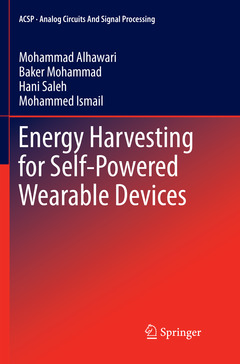Description
Energy Harvesting for Self-Powered Wearable Devices, 1st ed. 2018
Analog Circuits and Signal Processing Series
Authors: Alhawari Mohammad, Mohammad Baker, Saleh Hani, Ismail Mohammed
Language: English
Subject for Energy Harvesting for Self-Powered Wearable Devices:
116.04 €
In Print (Delivery period: 15 days).
Add to cartPublication date: 08-2018
Support: Print on demand
116.04 €
In Print (Delivery period: 15 days).
Add to cartPublication date: 08-2017
Support: Print on demand
Description
/li>Contents
/li>Biography
/li>Comment
/li>
This book discusses the design and implementation of energy harvesting systems targeting wearable devices. The authors describe in detail the different energy harvesting sources that can be utilized for powering low-power devices in general, focusing on the best candidates for wearable applications. Coverage also includes state-of-the-art interface circuits, which can be used to accept energy from harvesters and deliver it to a device in the most efficient way. Finally, the authors present power management circuits for using multiple energy harvesting sources at the same time to power devices and to enhance efficiency of the system.
Mohammad Alhawari received the B.S. degree in electronic engineering from Yarmouk University, Jordan, in 2008 and the M.S. degree in microsystems engineering from Masdar Institute of Science and Technology, Abu Dhabi, in 2012. He received the PhD degree in electrical and computer engineering from Khalifa University of Science, Technology in 2016. From 2008 to 2010, he worked at YOUNIVATE Company in Jordan, as a hardware and PCB engineer. He is currently a post-doctoral research fellow at Khalifa University, where he focuses on low power designs for energy harvesting applications.
Baker Mohammad earned his PhD from University of Texas at Austin, his M.S. from Arizona State University, Tempe, and BS from the University of New Mexico, Albuquerque, all in ECE. Dr. Mohammad is currently an associate Professor at the Department of Electrical and Computer Engineering at Khalifa University and a founding and active member of Khalifa University Semiconductor Research Center. He is a Senior Member of the IEEE and serves as an editor to the microelectronics journal, Elsevier. Baker Served in many organization and technical committee for IEEE conferences, In addition, he is a frequent reviewer for many journals including IEEE TVLSI, IEEE Circuits and Systems, and Springer. Baker has extensive experience for attracting and managing research grants including SRC, ADEC, UAE Space Agency and KU internal funding.
Prior to joining Khalifa University (KU) Baker has over 16-years industrial experience working for intel and Qualcomm in microprocessor design with emphasis on embedded system, and low power design. His research interest includes power efficient computing, high yield embedded memory, emerging technology such as memristor, STTRAM, computer architecture, and In-Memory-Computing. In addition, he is engaged in micro-watt range computing platform for WSN focusing on energy harvesting and power management inclu
Provides a comprehensive overview of the available energy harvesting sources and their usage, model and characteristics;
Enables engineers to understand the challenges of using energy harvesting systems and to design proper interface circuits for a particular application;
Presents characterization data of human-body thermal and vibrational energy harvesting, using off the shelf components;
Shows state-of-the-art power management methods for controlling the power harvested, stored and delivered to the load.
Includes supplementary material: sn.pub/extras

